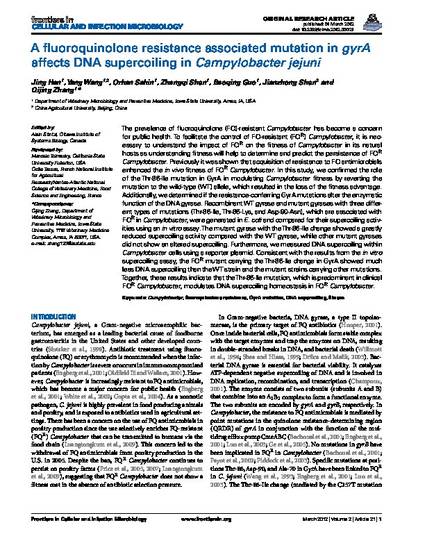
Article
A fluoroquinolone resistance associated mutation in gyrA affects DNA supercoiling in Campylobacter jejuni
Frontiers in Celluar and Infection Microbiology
Document Type
Article
Disciplines
Publication Version
Published Version
Publication Date
3-1-2012
DOI
10.3389/fcimb.2012.00021
Abstract
The prevalence of fluoroquinolone (FQ)-resistant Campylobacter has become a concern for public health. To facilitate the control of FQ-resistant (FQR) Campylobacter, it is necessary to understand the impact of FQR on the fitness of Campylobacter in its natural hosts as understanding fitness will help to determine and predict the persistence of FQRCampylobacter. Previously it was shown that acquisition of resistance to FQ antimicrobials enhanced the in vivo fitness of FQRCampylobacter. In this study, we confirmed the role of the Thr-86-Ile mutation in GyrA in modulating Campylobacter fitness by reverting the mutation to the wild-type (WT) allele, which resulted in the loss of the fitness advantage. Additionally, we determined if the resistance-conferring GyrA mutations alter the enzymatic function of the DNA gyrase. Recombinant WT gyrase and mutant gyrases with three different types of mutations (Thr-86-Ile, Thr-86-Lys, and Asp-90-Asn), which are associated with FQR in Campylobacter, were generated in E. coli and compared for their supercoiling activities using an in vitro assay. The mutant gyrase with the Thr-86-Ile change showed a greatly reduced supercoiling activity compared with the WT gyrase, while other mutant gyrases did not show an altered supercoiling. Furthermore, we measured DNA supercoiling within Campylobacter cells using a reporter plasmid. Consistent with the results from the in vitro supercoiling assay, the FQR mutant carrying the Thr-86-Ile change in GyrA showed much less DNA supercoiling than the WT strain and the mutant strains carrying other mutations. Together, these results indicate that the Thr-86-Ile mutation, which is predominant in clinical FQRCampylobacter, modulates DNA supercoiling homeostasis in FQRCampylobacter.
Creative Commons License
Creative Commons Attribution-Noncommercial 3.0
Copyright Owner
Han, Wang, Sahin, Shen, Guo, Shen and Zhang
Copyright Date
2012
Language
en
File Format
application/pdf
Citation Information
Jing Han, Yang Wang, Orhan Sahin, Zhangqi Shen, et al.. "A fluoroquinolone resistance associated mutation in gyrA affects DNA supercoiling in Campylobacter jejuni" Frontiers in Celluar and Infection Microbiology Vol. 2 (2012) p. 21 Available at: http://works.bepress.com/qijing-zhang/31/

This article is published as Han, Jing, Yang Wang, Orhan Sahin, Zhangqi Shen, Baoqing Guo, Jianzhong Shen, and Qijing Zhang. "A Fluoroquinolone Resistance Associated Mutation in gyrA Affects DNA Supercoiling in Campylobacter jejuni." Frontiers in Cellular and Infection Microbiology 2 (2012): 21. doi:10.3389/fcimb.2012.00021. Posted with permission.